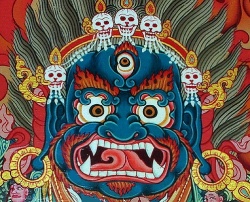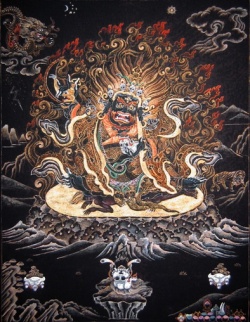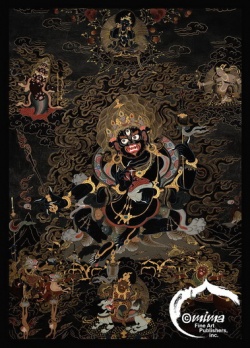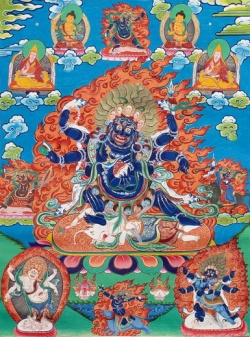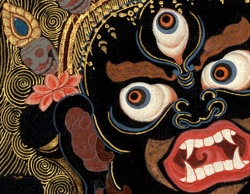The Many Forms of Mahakala, Protector of Buddhist Monasteries
The Dhe-Tsang Monastery, built in 1414 by a close Disciple of Je Tsongkhapa is situated in the Gyalrong district of eastern Tibet. When its founder, Ngawang Drakpa, came to the region intending to build a Monastery there, he realized that the place was special but couldn't decide on the best location to build the hermitage. At that very moment, a huge crow swooped down on him,
picked off his scarf, and flew away with it. The Monk hastened to follow the crow. Eventually, the garment was found hanging from the branches of a Juniper tree. Here it is relevant to observe that the crow is visualized in Tibetan Buddhism as an incarnation of Mahakala, whose name literally means the 'Great Black One.' Taking this occurrence to be an auspicious omen, Ngawang decided to build the Monastery around the tree, which would itself serve as a natural pillar of the prayer hall.
During the actual construction of the Monastery, the revered Monk faced many obstructions from the local Bonpo masters who practiced a primitive Form of shamanism and thus felt threatened by the unfolding of the Buddhist Faith in Tibet. Whatever was constructed of the building during the day would collapse during the night. These mishaps were attributed to the black magic performed by the Bonpos. One day, when Ngawang Drakpa was contemplating the problem, the crow reappeared.
Much relieved by its presence, the Venerable Monk wrote a letter to his Guru Tsongkhapa in Lhasa, asking for help. The master in response to his pupil's plea then composed a practice brimming with Spiritual potency and gave it the name: 'The Solitary Hero Vajra Bhairava Sadhana.' He gave it to the crow to deliver it to Ngawang Drakpa. When the latter received the manual he performed the practice immediately, which led to the subduing of all the leading Bonpo priests. This text later became one of the most significant one used in all Gelukpa Monasteries and retains its popularity to the present day.
When the major part of construction was completed, the Lama began to look for master sculptors who could create spiritually charged images for the Retreat. One day, three black men came to the Monastery and stayed there for some time. They later revealed that they were sculptors from India. Delighted on hearing this, Ngawang Drakpa eagerly sought their services in building
the required deity statues. Of the three men from India, only one agreed to stay on and help. As per his promise, the sculptor created all the statues requested except that of Mahakala, which alas, was only half-finished when the day of inauguration arrived.
The celebrations for the occasion consisted of various Ritual dance performances. At the end of the program, the Indian sculptor declared that he too wished to perform a dance for the contemplation of the audience and proceeded to enthrall them with an exceptionally energetic performance wearing a swirling costume and a large wrathful mask, leaving the viewers in raptures. Towards the
conclusion of the dance, his physical Form suddenly started to shrink until finally only the giant mask remained on the ground and there was no trace of the Body of the dancer. Taken aback by the bizarre turn of events, the Monks rushed to the chamber where the half finished statue of Mahakala lay. To their utter surprise, the statue was complete. The sculptor had merged with his creation, granting it an unparalleled Spiritual potency.
The story does not end here however. Later they were informed that the two companions of the Indian sculptor, who had declined to stay on, had each made a Mahakala statue at two different Monasteries and had likewise mysteriously disappeared into their respective creations. It was not long before the perceptive adepts realized that these sculptors were none other than the great
God Mahakala in his various manifestations, incarnating himself as the savior and protector of Monasteries. Thus at Ngawang's hermitage he was the Six-Armed Mahakala and had created a sculpture of himself with half-a-dozen hands. In a similar manner the other two had created icons of the Four-Armed and the White Mahakala respectively. Collectively, they were named the three Mahakala brothers and became vastly popular all over Tibet.
Though Mahakala's image is honored in all Tibetan Monasteries, it is only at Dhe-Tsang that he is regarded as a living member of The Sangha. Thus for example during Offering ceremonies it is still customary for the chant leader to announce: "Do not forget the black man's share," and the same of what each Monk receives is also set aside for Mahakala and presented to his sacred image. This tradition originated in the fact that when the so called 'black man from India' was sculpting the icons and was asked
what he desired in return for his services replied "Only that much that is offered to the Monks." When counting the number of residents at this exceptional Monastery, this generous protector is also taken as a member. As an interesting fact it should be mentioned here that this Monastery was destroyed in the 1950's, falling victim to the political and revolutionary activities of the day. It was however, rebuild spectacularly and was reopened in 1997, with the best wishes and participation of 170 representatives from fifteen nations under the patronage of his holiness Khejok Rinpoche.
The Symbolic Iconography of the Three Mahakala Brothers
Each of the three forms of Mahakala has some distinctly different qualities and aspects, symbolized by the physical forms and also the various implements they hold in their hands.
The Six-Armed (Shadbhuja) Mahakala (mGon po phyag drug pa)
This Form is most favored by the Gelukpa order of Tibetan Buddhism, and in this manifestation Mahakala is considered to be the fierce and powerful emanation of Avalokiteshvara, the Bodhisattva of Compassion.
He is adorned with the following symbolic attributes:
1). A crown of five skulls: This is worn by all manifestations of Mahakala and represents the transmutation of the five negative Afflictions of Human nature into positive virtues.
Thus:
a). Ignorance transforms into the Wisdom of reality.
b). Pride becomes the Wisdom of sameness.
c). Attachment becomes the Wisdom of discernment.
d). Jealousy becomes the Wisdom of accomplishment.
e). Anger becomes mirror like Wisdom.
2). The Six Arms signify the successful completion of the six perfections (shad-paramita), which are practiced and brought to perfection by Bodhisattvas during the course of their training. These are:
a). The perfection of Generosity (Dana-paramita)
b). Morality (shila-paramita)
c). Peace (shanti-paramita)
d). Vigor (Virya-paramita)
e). Meditation (Dhyana-paramita)
f). Insightful Wisdom (Prajna-paramita)
3). The arms hold various implements each of which has a symbolic significance:
a). The first right hand holds a curved knife. In Mahakala's symbolism the curved knife cuts through the Life veins of enemies such as oath-breakers and hindering spirits.
b). The skull cup in his primary left hand is filled with the Heart-blood of these enemies.
The crescent shaped chopper of the right hand corresponds in shape to the cavity of the skull cup and functions to make 'mincemeat' of the hearts, intestines, lungs, and Life-veins of enemies hostile to the Dharma, which are then collected in the skull cup. A similar crescent shaped hand cleaver is used in oriental cuisine to chop meat and dice vegetables.
c). The next right hand holds a Damaru - the hourglass-shaped drum, signifying the primordial Sound from which is said to have originated all manifested existence. Its rattle is also said to emanate the Sound that arouses us from our ignorant state, coaxing us on to the path of Dharma.
d). The uppermost right hand holds a rosary of skulls. The continuous counting of the rosary is a Symbol of perpetual activity, which Mahakala achieves on a cosmic scale.
e). Another left hand holds a trident which represents the Three Jewels of Buddhism, The Buddha, the Dharma, and The Sangha.
f). Finally there is the noose for lassoing those of us who have strayed away from the path of the Dharma.
The Six-armed Mahakala's left leg is outstretched while the right is bent at the knee. The former symbolizes his accomplishments for the benefit of others and the latter those for himself. An elephant-headed entity lying crushed under his legs represents our instinctive, primary animal force and urge, which when unleashed can prove to be extremely destructive. These cravings however, can also be extremely useful to our self-development and -realization when we master them and bring them under our moderation. Indeed, it is warned that dreaming about a herd of Elephants is a sign that instinctive and irrepressible forces that may have been suppressed for too long are about to be unleashed.
The sun-disc on which Mahakala stands denotes his illumination of the darkness of Ignorance, and the Lotus on which this disc rests signifies his undefiled purity.
The blazing Fire surrounding him demonstrates his powerful energy out to consume all neurotic states of minds. Further, his three organs of vision express his ability to see the past, present and future. That he stares at the World with wide eyes signifies that he is incensed at the current state of affairs.
Snakes slither across his Body as ornaments and also as the scared thread of Brahmins. The writhing serpent is a metaphor for the stirring of our psychic instinctive and primordial energy and Mahakala's wearing them as adornments expresses the fact that rather than impede our Spiritual progress, such emotions have been tamed and harnessed, becoming in the process, crowning glories of our Spiritual achievements.
The Four-Armed (Chatur-bhuja) Mahakala (mGon po phyag bzhi pa)
The four arms of this manifestation of Mahakala perform one of the following four positive karmas or actions, which are said to be his specific boon to his worshippers:
a). Pacify sickness, hindrances, and troubles.
b). Increase Life, good qualities and Wisdom.
c). Attract whatever Dharma practitioners need and bring people to the Dharma.
d). Destroy confusion, Doubt, and Ignorance.
In addition to the ubiquitous skull cup and chopper, the Chatur-bhuja Mahakala holds in his other two arms a khatvanga (left hand) and flaming sword respectively. The khatvanga is a kind of Ritual staff having three human heads at the upper end. These represent the overcoming of the Three Roots of Evil, namely Greed (Raga), ill will (Dvesha), and Delusion (Moha).
The sword is the flaming weapon of transcendental Wisdom (Prajna) with which Mahakala destroys Ignorance. The latter is the principal attribute of Buddhist deities especially associated with overcoming Ignorance and embodying the Wisdom aspect of Enlightenment within their physical forms.
The four-armed Mahakala is significant to the Nyingma school of Tibetan Buddhism.
The White Mahakala (Skt. Shad-bhuja Sita Mahakala; Tib. mGon po yid bzhin nor bu)
This is the Wealth aspect of Mahakala which specifically supports the comfort and economic well-being of tantric practitioners. The following description is according to his sadhana:
"His Body is white. His face is wrathful and he has three eyes. He has six arms. His main right hand holds a wish- fulfilling jewel (chintamani) mounted on a jewel-tipped handle, in front of his chest."
The White Mahakala is known as mGon po yid bzhin nor bu in Tibetan with the last four meaning 'Wish-Granting Gem,' and he is the special protector of Mongolian Buddhists. His iconography is rich in symbols delineating his 'Wealth-deity' status. For example his skull bowl, rather than contain the mortal remains of his victims, is full of various jewels,and his crown is made up of five jewels instead of the trademark five skulls.
